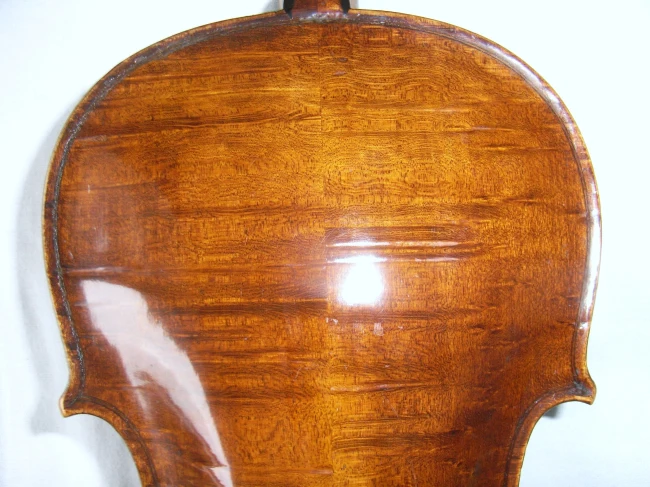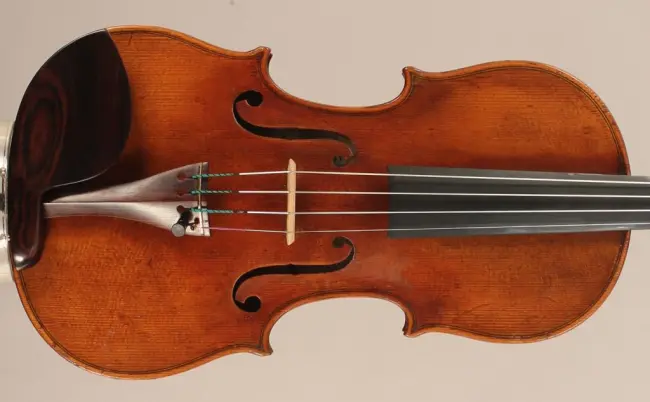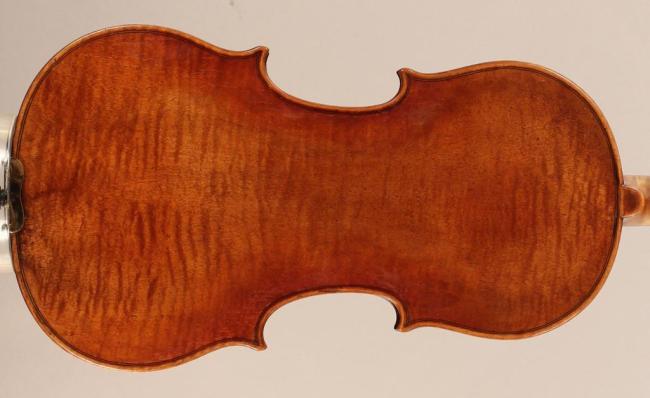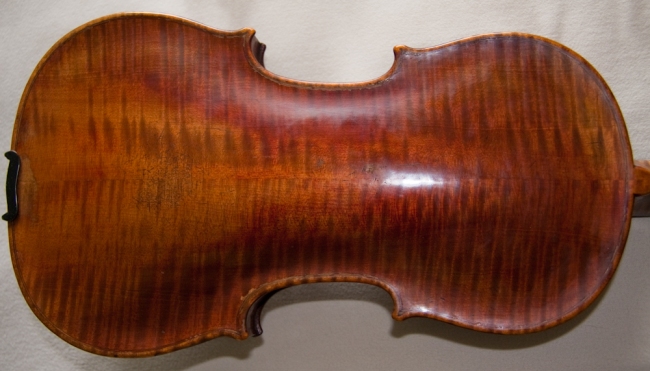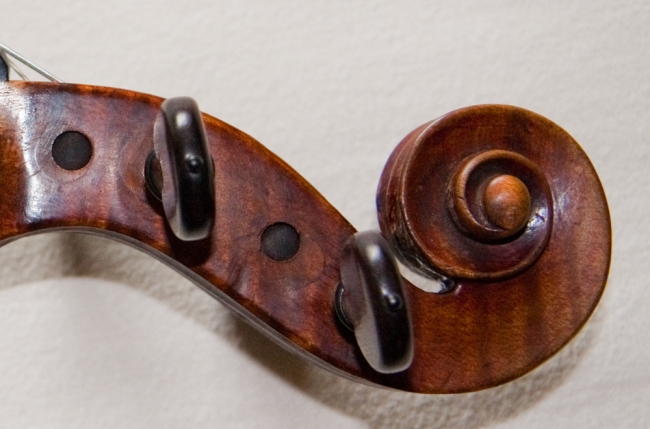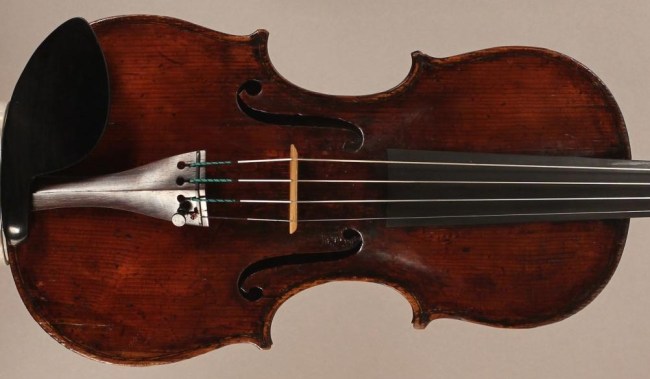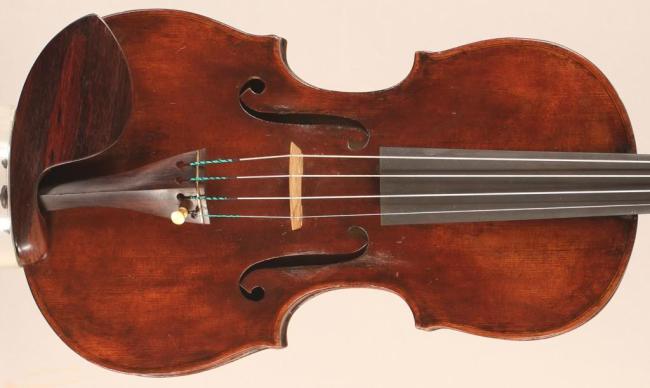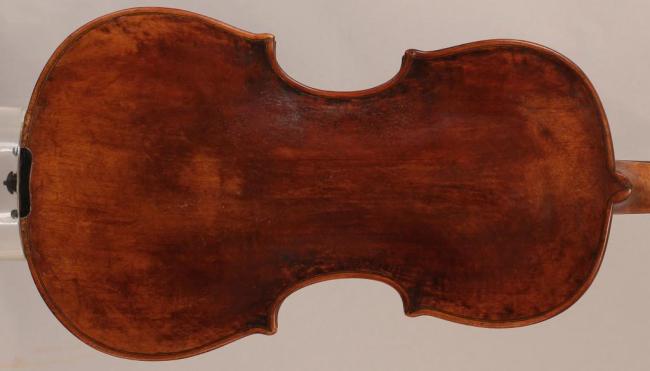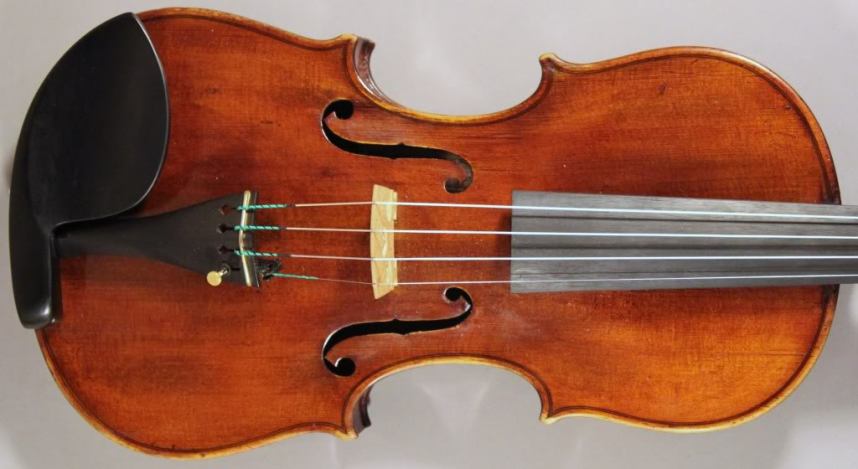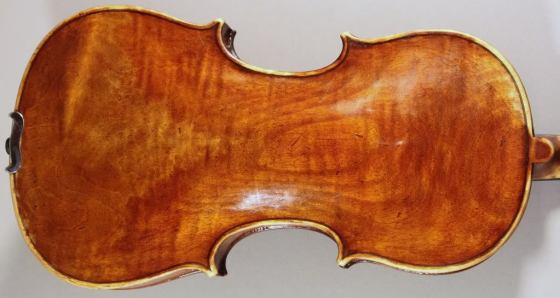Tags
antique violin, Carl Freidrich Hopf, Dietrich Kohnermann, Ernst Heinrich Roth, Freidrich August Glass, German violin, Glass violin, Heberlein, Hopf violin, Klotz violin, Kohnemann, Kretzschmann, old violin, quality violin, Roth violin, vintage violin, violin, violin value, Violinmaker, violins
The general perception of German violins is that they are inferior to and of lower quality than French or Italian made violins. Certainly they are considerably less expensive in general than their counterparts from these two countries. Is this justified though?
Photo: VirtuosiViolins.com
The price of violins follows a general hierarchy according to country of origin, with Italians being the most expensive with French next and some way behind German violins. This hierarchy is to some extent a reflection of the collectability of violins from these respective countries and the esteem that top class musicians hold for them, but it is also very much an affect of the degree of mass production of cheap instruments in those countries. Italy had very little of this. Meanwhile it happened to a degree in France and this pulls down the price that will be paid for French violins, but nowhere to the extent that it does with German violins where production of violins took place on a near industrial scale, flooding the market with cheap instruments and threatening the livelihood of quality craftsman throughout Europe as far back as the days of Antonio Stradivari. In fact Antonio Stradivari was one of the few violinmakers in Cremona even in its golden age of violinmaking who could consistently command such prices that he did not have to lower the quality of his materials or cut corners in order to turn out larger numbers of more quickly produced instruments due to the influx of cheaper instruments from Germany. Along with an economic downturn affecting Europe, this affect increasingly impacted on the quality of Italian violins across the generations in general with only a handful of makers adhering to the highest values of craftsmanship that the great names of the golden age of Cremona established.
Does it make any sense though? Just because there is mass production of lower quality instruments in a particular country does it mean that all instruments produced there are of a lower quality and worth less? Does it mean that there are no craftsman adhering to the highest principles of violinmaking, using the best techniques and working with the finest quality materials? In the world of car manufacture we have cheap run-around FIAT’s produced in Italy, the very same country that produces Ferrari, Lamborghini and Masseratti cars. Yet I do not see little FIAT 500’s fetching many times the price of a German made Mini because it is made in the same country as these sleek sports car companies that utilize the heights of modern engineering technology. Nor are these supercars cheapened and regarded as inferior because the Ferrari roaring from 0-60mph in a few fractions of a second is a stable mate of the little FIAT Panda that barely has enough speed to frighten a hedgehog. Yes, there are other factors at play when it comes to the price of violins that impact on the prices they fetch and how they are generally looked upon. One of these is the huge kudos of owning or playing an Italian violin – some call it snobbery but for me that is too superficial and does not really encompass the depth of psychology involved here. For certain individuals there may be a degree of pride and superiority in playing an Italian violin but for many there is something far deeper and more important. One of the conclusions of researchers into what makes Italian violins (usually the focus is on Stradivarius instruments) so good is that there is a large psychological component amongst musicians (and again they are usually referring to top musicians and soloists). The belief that they are playing the best instruments available gives them a greater belief that they can deliver a better performance and convey everything that they possibly can if they are using the finest instruments. Blind tests have so far proved at best inconclusive in demonstrating a musician’s, or an audience’s, ability to distinguish between a Stradivarius and other old instruments or between these and new instruments, regardless of their country of origin – and most of these studies have shown that neither audience nor musician can reliably and consistently make the distinction. So, is it all in the mind? Probably not! Any violin still has to have certain qualities to make them suitable for the modern soloist and one of the most important of these is the ability to be heard right to the back of the modern concert hall and to cut through the sound of a full orchestra in doing so. There is no denying that instruments made by Stradivari, Guarneri del Gesu and other Italian makers of the Golden Era, and to a lesser extent beyond, most consistently possess these characteristics. The reverence that these violins have amongst elite musicians has undoubtedly had an impact on the desirability of Italian violins in general and hence the demand for them has had a strong upward pressure on their prices. However, the top Cremonese makers do not have an exclusivity on producing violins with the qualities referred to as making them desirable by the elite – never mind the fact that most musicians do not need and would probably not want violins with such qualities. You only have to listen to Nicola Benedetti talk about her Stradivarius and how demanding it is to play (she refers to it as a monster that she is constantly having to fight with), how for all its beautiful qualities it does not sound pleasant under her ear, and how it would be totally unsuited to Scottish folk virtuoso Ally Bain. There were many other luthiers throughout the history of violinmaking and from all nations that have produced such qualities in their violins and certainly the best makers of today can produce violins with whatever tonal qualities you require.
Kristian Tetzlef famously plays a modern German violin made by Stefan-Peter Greiner and favours it over a Stradivari. The Greiner has every quality that he requires and being youthful, strong and healthy it makes life on the concert circuit much easier for him. Tetzlef refers to how much prejudice there is against modern instruments, commenting that the great Italian masters like Stradivari, Guarneri and others had an extraordinary ear for just what a violin can do but that there are some current makers that similarly have a great ear for this (The Strad Magazine, April 2013). It is his opinion that the moment an audience don’t know that you are not playing a Strad they do not see any difference.
One of the highest regarded current makers is the American Sam Zygmuntiwicz who has been commissioned by many great soloists including Isaac Stern, Maxim Vengerov, Joshua Bell and every member of the Emerson String Quartet . A violin made by him held the record for the highest price paid at auction for a violin by a living maker, $130,000, until very recently (A copy of the ‘Huberman’ Guarneri del Gesu made for American virtuoso violinist Ruggiero Ricci in 1985 by Curtin & Alf has just beaten this record by $2000 in an auction by Tarisio in New York). Zygmuntiwicz has a four year waiting list for commissions that sell for in the region of $50,000 and he has been referred to as ‘the modern Stradivari’. A 1979 violin made by Sergio Peresson, who was born in Italy and moved to Venezuela after four years of making violins and then 16 years later to Philadelphia, is favoured by virtuoso violinist Eugene Foder over his Guarneri del Gesu. This all demonstrates that it is not just the sole preserve of Golden Age Italian instruments to produce the amazing sound qualities that great solo violinists require.
One of the factors which is often referred to as inflating the prices of Italian violins is their relative scarcity. They were not produced in the numbers that violins were in Germany and the finite pool of old high quality Italian instruments is always diminishing, with every year a few being lost, stolen or damaged beyond repair (not to mention those lost to musicians by them being acquired by museums, investors and collectors). Can this not be countered though with the argument that although German violins per se may be abundant the highest quality German instruments are relatively scarce amongst the masses of German violins produced?
Surely a more sane approach is to take every instrument on its own merit, regardless of who made it or from which country it originates. After all, even Antonio Stradivari made some poor sounding instruments (some to the extent that he refused to sell them in his lifetime) and a significant number of violins by the famed Jean-Baptiste Vuillaume are said to have excellent tone in the lower range but are poor above third position. If you are prepared to take this approach, even if it does fly in the face of conventional thinking, then you can land yourself with an exceptional instrument of equal quality to an Italian violin way out of most people’s pockets. Most people may never be able to afford a great Italian made violin but the best of German violins can be very affordable. So here are just a few of the quality craftsman that have lived up to the high ideals of the great Italian makers; and here I am listing only those that I can vouch for having had personal experience of their work.
Freidrich August Glass worked in Klingenthal from 1830-1860. William Henley describes him (in The Universal Dictionary of Violin and Bow Makers, p468) as “A man bent on improving the often imperfect types issuing from Saxonian hands”. It is also noted that in London he was awarded a gold medal for his outstanding work. The best of his violins have been described as sounding like the best Italian violins made at that time, and comparable to a Ceruti or Gagliano. The choice of wood is often superb both acoustically and decoratively.
Figure 1: Rare curly and birds-eye maple back on violin by Freidrich August Glass (Photo: Virtuosi Violins)
A good number of the violins made Glass ended up in America, where the one shown in Figure 1 was found. It was sufficiently highly regarded as to have been entrusted for repairs in 1900 to the important American maker D.B. Rockwell, and may well be when it had the neck graft, peg rebush and fitting of a modern base bar. Violins by this maker are certainly very well worth serious consideration.
Ernst Heinrich Roth is one of the most highly respected names in German violinmaking. He modelled his creations after Stradivari, Guarneri, Amati, Guadagnini and a few other leading makers, as well as having his own special models. He is noted as being extremely versatile and every instrument he produced demonstrated individuality. He used only the very best wood, carefully selected for its tonal properties. Roth paid fine attention to every little detail and his instruments were finished in beautiful varnish of elasticity to match those emanating from Cremona. Virtuoso musicians including the likes of Marteau and Felix Berber have attested to the quality of his violins, which have been referred to as “Violins for the Artist” (William Henley, in The Universal Dictionary of Violin and Bow Makers, p990)
These photographs show a wonderful 1923 example of Ernst Heinrich Roth’s work. This one is a rare copy of a Frencesco Ruggeri violin. It is a very beautiful sounding violin; powerful and with dark grandeur.
Good Roth violins like this one not only make fantastic musicians’ instruments, up to the very highest levels, but are also becoming very collectable. With top Italian and French instruments becoming increasingly less available, both in terms of numbers on the market and their price tags, German violins by their very best master craftsman are next in line; and as such are likely to see significant price rises in the near future giving them good investment prospects – which will add to their collectability, and so the cycle begins.
Carl Freidrich Hopf is one of the many German makers with the name Hopf and indeed the name was adopted for many of the mass produced instruments emanating from that country. However, Carl Freidrich (1811-1892), Caspar (1650-1711) and Christain Donat were the outstanding makers of this prolific family and whose quality of workmanship gave the name its fame that the mass producers hijacked. These three were on a completely different level to the other members of the family and the manufacturers violins. All three worked from Klingenthal (although Carl Freidrich moved to Brunndӧbra, Saxony in 1862) and aspired to the heights of workmanship found in their Italian counterparts.
The violin pictured above is of a fine example of Carl Freidrich Hopf’s work from around 1870. It is made from excellent materials, has wonderful proportions and the deftly carved scroll is testament to the superb craftsmanship used in the making of this violin.
Photos courtesy of Virtuosi Violins
Indeed William Henley (Universal Dictionary of Violin and Bow Makers p586) describes his workmanship as “completely desirable”. It is a violin that has a strong, penetrative sound and persistent sound; very resonant and well centred. The G string is wonderfully deep whilst the treble side is vibrant and warm. It is a total pleasure to play.
There are two outstanding members of the Kretzschmann family, Georg Carl Kretzschmann and Johann Adam Ketzschmann who worked from Markneukirchen. Georg Carl is regarded as the best maker in that region of that time and became a Master in the Violin Makers’ Guild in 1723. His choice of wood is excellent and his violins have an old worldly full tone. Typically his violins are medium arched Amati models. Whilst he lived to a good 81 years of age, Johann Adam lived a more stellar life but died at the age of only 46. He was so naturally gifted that by the time he was 18 he had become a Master in the Violin Makers’ Guild. His workmanship is considered superior to anything produced in the region by any of his contemporaries. The best of his violins are built to Guarneri modelling with marginally increased arching and are covered in a lusciously rich golden brown varnish. They are typically of a nice full tone, have a deep bass register, a good responsiveness and are pleasantly mellow.
The above pictured violin is a beautiful example of Johann Adam Kretchnann’s work, and is very typical in both craftsmanship and tonal qualities.
A further very well known family of violinmakers from Markneukichen, that has spanned several generations, is the Heberlein family. Of these the ones that made instruments of noteworthy quality were Heinrich Theodor Heberlein, Jr and Richard Heberlein. Most of the others produced little better than commercial grade instruments. The first named was a master in not only the art of violinmaking but the more dark art of commerce, and successfully achieved what few before had by combining the two. Putting every effort into careful modelling, attention to detail and finishing each instrument with a beautiful shade of varnish, whilst still producing a wonderfully clear tone, Heinrich Theodor soon headed off all his competition. As William Henley so charismatically puts it (in Universal Dictionary of Violin and Bow Makers p548) he “abundantly proved the possibility of putting every conceivable detail of finely finished workmanship to a marketable commodity, yet kept the price only slightly in advance of the many botches that had previously emanated from the workshops of Markneukirchen.” Heinrich Theodor is known to have amassed around a dozen medals from various exhibitions around Europe.
Meanwhile Richard Heberlein, born 19 years later in 1862, moved away from Markneukirchen to eventually settle in Nurnberg in 1892. His violins were of a quality that few could surpass. His workmanship was supreme in every detail and were finished in a varnish to match those applied in Italy. Together with tonal qualities that have attracted sufficient attention for a number of solo players to use them in public performances Richard Heberlein violins have earned him a reputation as the finest of Germany’s violinmakers.
Then there are violins from, shall we call them, ‘less celebrated’ makers who have produced instruments that have matured to have the most wonderful tone. There are always great German violins to be found outside of the recognized names. Dietrich Kohnemann gets only two lines in Henley’s Universal Dictionary (p659), commenting that he worked in Harsum from 1837-1869, and upon the good quality of his workmanship.
The above is a wonderful violin by Dietrich Kohnemann, from 1839. It is small by modern standards with a back length of only 352mm and the modelling in general heralds back to violins from a hundred years earlier. It may not be aesthetically pleasing to every eye with the small, well worn corners but it makes up for it with its delightful tonal qualities. It has the typical ease of response found in smaller length violins whilst having the power and projection expected of larger dimension violins. It is worth recalling that most of Guarneri del Gesu’s violins were no bigger than this. The Kohnemann, as well as being strong, is also incredibly warm and has a gorgeously deep base voice. Whilst maple is the wood of choice for backs today it was not uncommon for classic makers to utilise acacia, which is the case for the single piece back of this violin.
Whilst it may seem plain compared to the highly decorative flamed backs so often seen, it is extraordinarily attractive in its simplicity; and the tonal qualities of the violin attest to it being a great choice of wood. The best makers knew that it was all about balance.
Whilst the above Kohnemann might not be the most aesthetic of instruments but has highly desirable tonal qualities, it is in contrast to the Klotz family of makers from Mittenwald. Sebastian Klotz, born in 1696 and son of Matthias (not to be confused with the later born namesake, son of Aegidius Klotz), was regarded as the foremost maker of the family. His violins are regarded as virtually flawless in their craftsmanship, a work of art inside and out. For all that though, and despite the fact that they were once highly regarded for their tonal beauty, they have been almost totally overlooked by professional and amateur musicians alike for the past hundred years or so. William Henley (in the Universal Dictionary of Violin and Bow Makers pp651-2) refers to their ‘lack of tonal stability’ and not having the ‘bright, free, full responsive and brilliant tone’ required today. So whilst the collector may choose a Klotz a musician would every time select the Kohnermann in preference.
So, in the final analysis I would recommend that you do not discount German violins because they are German, rather than French or Italian. If you are a collector or investor then the country of origin, the name of the maker and that the violin is verifiably made by that person is of importance. If you are a musician then the paramount considerations are the condition of the violin, its build quality and tonal attributes, perhaps together with playability or projection. Take is each instrument on its individual merits, regardless of which country it comes from or the name on the label and you are much more likely to get the violin most suited to you and your needs at the best possible price.


